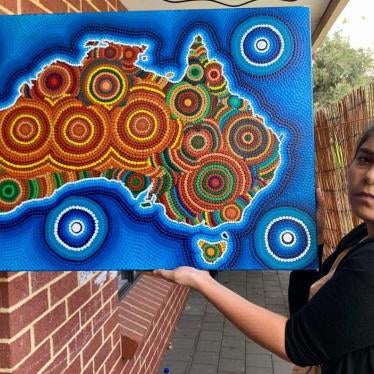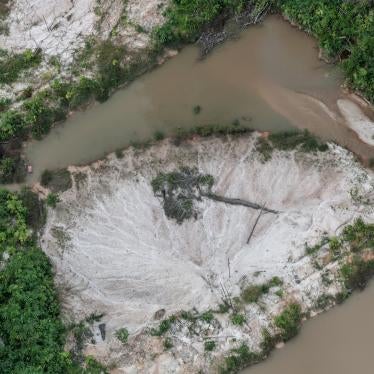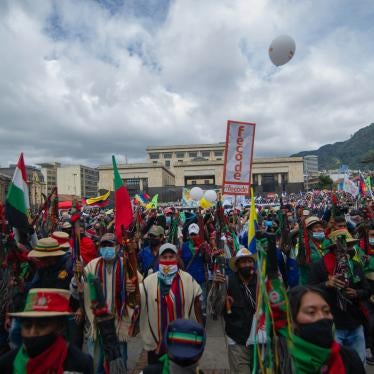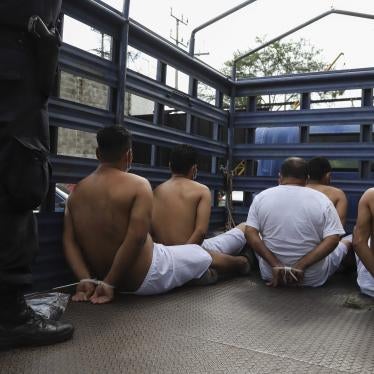Introduction
Human Rights Watch is pleased to have the opportunity to offer input for the Committee’s Day of General Discussion on the rights of Indigenous women and girls. Human Rights Watch has documented the rights challenges faced by Indigenous women and girls around the world. This submission focuses on three areas of the Committee’s report where we have research: 1) Rights with individual and collective dimension; 2) Specific rights recognized by the Convention on the Elimination of All Forms of Discrimination against Women; and 3) Situations of greater vulnerability that require urgent and priority attention. We hope the examples provided from our research may help guide the Committee in its work. We would also like to direct the Committee to a Human Rights Watch submission in March 2021 to the Expert Mechanism on the Rights of Indigenous Peoples on the Rights of the Indigenous Child, which includes additional relevant information for the Committee regarding the rights of Indigenous girls, including detailed recommendations.
I. “Rights with Individual and Collective Dimension”
A. Land Rights
Oil Palm Plantations and Rights Violations related to Land in Indonesia
Human Rights Watch has documented the impact of oil palm production on the rights of Indigenous women in Indonesia.
Conflicts related to land are pervasive and have frequently been linked to oil palm plantations. Konsorsium Pembaruan Agraria (Consortium for Agrarian Reform), an Indonesian nongovernmental organization, documented more than 650 land-related conflicts affecting over 650,000 households in 2017, and about 410 conflicts affecting 87,568 households in 2018.Various Indonesian laws, starting from 1999, require companies seeking to develop oil palm plantations to consult local communities at every stage of the process to obtain government permits. Companies have responsibilities under international law to have ongoing consultations with communities. In its research, Human Rights Watch found no evidence oil palm plantations it investigated had adequately consulted with affected households until after forests were significantly destroyed. In West Kalimantan, some families were forced to relocate their homes a few kilometers into the plantation but did not receive any compensation for the loss of their indigenous forest and livelihoods derived from it. Their community is now enclaved within the company’s oil palm plantation, leaving them no land for gardens. The forest has been largely destroyed, clearing plants they use for food and materials used to make mats and baskets they sell to supplement household revenue. Community members said company representatives burned down their traditional homes at the old village, including the belongings of residents who refused to relocate.
The forest itself has been irrevocably changed. In the past, the forest provided community members with most of their needs—from food to rattan. Many Orang Rimba in Jambi province are now homeless, living in plastic tents, and without livelihood support. Some Orang Rimba said they had been self-sufficient but are now reduced to begging on the highway or “stealing” oil palm fruits from the plantation area to sell and make money. Many now live in abject poverty.
Women experienced distinct losses in passing on intergenerational knowledge and skills, such as weaving mats and baskets made from forest products. Several Indigenous women told Human Rights Watch they had lost sources of supplemental income.
Deforestation on such massive scale threatens not only the wellbeing and culture of the Indigenous populations, but also has global significance associated with climate change.
B. Rights to Water and Food
Impacts on First Nations’ Right to Water and Food in Canada
Across Canada, Indigenous families experience disproportionate levels of food insecurity, largely as a result of historic marginalization and the impacts of colonialism. For example, some studies find nearly one in two households in First Nations are food insecure, compared with one out of nine white Canadian households.
First Nations women often serve as caregivers who harvest and prepare traditional foods for their families and communities and are very concerned about ensuring the harvest is adequate, in particular, to support children. Where families are not able to harvest enough food from the land or to receive harvested food from others in their community, they must rely on expensive, store-bought food.
First Nations in remote locations have a compounded risk of food poverty because on average household incomes are lower, and higher transportation costs drive food prices higher than elsewhere in the country. Healthy foods in particular, such as fruits and vegetables, are often cost-prohibitive in remote grocery stores. As a result, First Nations people told Human Rights Watch they tend to eat more affordable, but less nutritious foods, compounding existing health disparities in northern communities tied to historic marginalization and poor access to health care. Academic studies show that increased dependence on processed, high-calorie, store-bought foods—often less expensive and with longer shelf-lives—has contributed to serious diet-related health issues among First Nations, including among First Nations children, such as the growing and disproportionate number of First Nations people affected by obesity and diabetes. Canada is also one of the most water-rich countries in the world, yet many First Nations people face daily challenges just to access safe water for drinking and hygiene—a fundamental human right easily enjoyed by most Canadians. Drinking water advisories exist for 52 water systems in 33 First Nations reserves across Canada, alerting communities that their water is not safe to drink.
Human Rights Watch has monitored this water crisis on First Nations reserves for over five years, and has found that it has persisted for decades due to the lack of regulations governing water quality for reserves, insufficient and arbitrary funding, tainted source water, and lack of capacity and support for water system operators. As a result, water on many reserves is not safe. Health impacts of exposure to contaminants found in the water can range from serious gastrointestinal disorders to increased risk of cancer. The water crisis also decreases the quality and quantity of water available for drinking and hygiene.
Caregivers, in particular women, shoulder extra burdens to ensure that children, elders, and others avoid exposure to unsafe water. Poor quality water can add hours to simple caregiving tasks. A mother in Neskantaga First Nation described the hour-long daily process to wash bottles for her 4-month-old infant with a rare heart condition. She bathes him in water that she or her partner collects from the community’s reverse osmosis machine at the water treatment plant. To bathe the baby, every two days she boils the water then lets it cool in a small tub. This takes about two hours. To wash her baby’s bottles, she first rinses the milk out with tap water. Then she boils water from the reverse osmosis machine with the bottles. She then washes them in the sink, again with the treated plant water. This takes an hour. “It makes me feel tired, exhausted. It’s stressful,” she said.
C. Cultural Rights
Impact of the Water Crisis in Canada on the Exercise of Cultural Rights
Many First Nations people in Canada consider water to be sacred and acknowledge a special cultural relationship with it. According to custom and tradition, women are the keepers and spiritual protectors of the waters, and their teachings guide First Nations peoples on how to care for the waters. In this relationship, water has the responsibility to purify, cleanse, and give life to the environment and all living things. Likewise, many First Nations communities recognize their responsibility to care for water. First Nations communities have ceremonies related to the care of water and have knowledge, customary laws, and ways of teaching their children about their special relationship with water. As one elder highly respected for her knowledge about water explained, “My relations with the water from the rivers, lakes and from the creeks, they are very close to me, they are my family.”
Water is fundamental to cultural life and the continuance of cultural knowledge for many First Nations peoples. As one scholar of First Nations traditions notes, “Our relationship to water also plays a vital role in passing on knowledge to younger generation.” Poor water quality at home and in traditional territories can therefore have a negative impact on First Nations people’s relationship to water, including their exercise of ceremony and traditional practices of hunting and fishing.
It is therefore important to consider First Nations peoples’ cultural and spiritual relationship with water both in understanding the impact of poor water quality and poor access to water and in formulating the right governmental response to these problems. Elders often feel that “their knowledge is not being incorporated in decision-making by the community or by other agents located off reserve, such as industry and governments” and that “that cultural or traditional teachings about water are a key factor missing from current decision-making processes regarding water.”
II. Specific Rights Recognized by CEDAW
A. Life Free of Violence
Canada: Systemic Discrimination against Indigenous Women and Vulnerability to Violence
In Canada, Indigenous women are particularly at risk to all forms of violence, including violence perpetrated by casual acquaintances and police abuse. Human Rights Watch has found that policing failures contribute to a climate of suspicion and a widely-held belief that the police targets and discriminates against Indigenous men and women with little accountability for violent and racist conduct. Indigenous women told Human Rights Watch that they would not call the police to report a crime committed against them or crimes that they had witnessed involving an Indigenous woman out of fear that the police may harass them, engage in physical violence towards the suspect, or other abusive behavior. There is a historical and colonial background to present-day patterns of violence against Indigenous women and girls, and police failures to respond to such violence. State law and policy, such as the Indian Residential School system, the Sixties Scoop, and sex discrimination in the Indian Act, subjected Indigenous families and communities to violence, cultural dislocation, and land dispossession. In 2015, the Truth and Reconciliation Commission of Canada described the cumulative effects of Canada’s Aboriginal assimilationist policies as a form of cultural genocide. The intergenerational impacts of this colonial violence upon Indigenous women and girls are acute. Indigenous women and girls today are disproportionately more vulnerable to socioeconomic marginalization than non-Indigenous women and girls. They are more likely to live in poverty, on the streets or in insecure housing, be unemployed, or engage in dangerous economic survival strategies.
In their inquiries into the murders and disappearances of Indigenous women and girls, this Committee and Inter-American Commission on Human Rights have affirmed that racist discrimination and socioeconomic marginalization were root causes of the violence.
In June 2019, the National Inquiry into Missing and Murdered Indigenous Women and Girls released their final report with 231 “Calls for Justice” to address this crisis. Two years later, the government released a national action plan on “Ending Violence Against Indigenous Women, Girls and 2SLGBTQQIA+ People” aimed at creating a roadmap to guide the Inquiry’s recommendations. Despite these efforts, progress continues to be slow in implementing these critical recommendations.
III. Situations that Create Greater Risk that Require Urgent and Priority Attention
A. Indigenous Women Human Rights Defenders
Threats and Killings in Colombia and Ecuador
Indigenous women face serious risks, including killings, gender-specific violence, and various forms of legal harassment when governments fail to protect their rights.
In Colombia, 21 Indigenous women human rights defenders were killed between 2016 and 2020, according to the Human Rights Ombudsperson’s Office. Most of them, were killed in the southern state of Cauca. Among them, Human Rights Watch documented the killing of Cristina Bautista Taquinás, a 30-year-old Nasa Indigenous authority. Taquinás, along with other Indigenous authorities of her community, secured the release of two Indigenous community members who were taken hostage by an armed group. When Taquinás and others attempted to block the flight of one of the armed group’s fighters with her car, other fighters at the scene opened fire on the car, killing Taquinás and five other Nasa people. One member of the armed group has been charged in connection with the killing.
In Ecuador, Human Rights Watch has documented how the prosecutor’s office maintained a criminal investigation open for years against environmental and Indigenous leaders who opposed oil exploration in the Ecuadorian Amazon, despite having no evidence to substantiate it. Human Rights Watch investigated these abuses in depth in 2018. Among those targeted by this form of judicial harassment were Gloria Ushigua, coordinator of the Sapara Women’s Association “Ashiñwaka” from Pastaza, and Patricia Gualinga, leader of the Kichwa people of Sarayaku—both Indigenous women have been vocal leaders of their communities. The investigation was open by the prosecutor in 2013—five years later, when Human Rights Watch inspected the file, it had nothing but generic documents. At the time, Ushigua told Human Rights Watch that she felt that as long as the prosecutor’s office kept the investigation open, it was as if a threat was hanging over her head (the file is not accessible remotely, Human Rights Watch could not confirm the current status of the investigation).
B. Indigenous Women in Detention
Over-Imprisonment, Neglect and Abuse of Aboriginal and Torres Strait Islander Women and Girls with Disabilities in Australia
Aboriginal and Torres Strait Islander women in prison are the fastest growing prison population, and 21 times more likely to be incarcerated than non-Indigenous peers in Australia.
Multiple forms of disadvantage mean that Aboriginal and Torres Strait Islander children, particularly girls, are more likely to end up in jail than non-Indigenous peers, including greater likelihood of living in out-of-home care, dropping out of school, being homeless, or having earlier and more frequent contact with the criminal justice system. Those Aboriginal and Torres Strait Islander women and girls who have disabilities experience added challenges: the disability is often undetected in childhood, and even when it is, support services are difficult to access, putting them on a path where they are more likely to be incarcerated than get a university degree.
Aboriginal and Torres Strait Islander women and girls with disabilities face multiple and compounding forms of disadvantage, discrimination, and abuse due to their gender, disability, and ethnicity.
Human Rights Watch research has also found that once in prison Aboriginal and Torres Strait Islander women with disabilities can often be seen as “easy targets” or “weak,” exposing them to a range of abuse including bullying; harassment; and verbal, physical, and sexual violence at the hand of other prisoners and staff.
For example, in the absence of support and accommodations, a woman with a psychosocial or cognitive disability may not understand or immediately follow orders to come out of a cell or raise her hands above her head. Custodial staff receive limited training on disability and mental health and can mistake their behavior as a prisoner “acting up” or being disobedient. Instead of providing psychosocial support and accommodations for a person’s disability, prison staff can reprimand or punish the prisoner for behavior that is perceived as “disruptive,” “disobedient,” or “acting up.” Human Rights Watch documented cases of people being sent to a punishment unit after experiencing anxiety or a crisis that medical staff did not manage on time. Human Rights Watch also found evidence of Aboriginal and Torres Strait Islander women spending days or weeks locked in solitary confinement in crisis or safety units for 22 hours or more a day, causing severe psychological distress and pushing many over the edge.
C. Indigenous Women and Natural Disasters and Climate Change
Climate Risks for First Nations Women and Girls in Canada
Climate change is having an outsized impact on Indigenous women and girls in Canada, increasing food poverty, and negatively impacting health and culture.
In a 2020 report, Human Rights Watch documented how climate change impacts—including more extreme weather, thawing permafrost, reduced snow and ice, and more wildfires—are depleting First Nations’ traditional food sources, increasing the danger and difficulty of harvesting and driving up the cost of imported alternatives. First Nations members Human Rights Watch interviewed described having to skip meals or purchase less healthy, but more affordable food in local stores to supplement inadequate supplies of traditional food. In several First Nations Human Rights Watch visited, teachers reported that some children do not get enough food at home. Social stigma surrounding poverty and fears related to the removal of First Nations children from their families by social services for poverty-related reasons present obstacles to families seeking assistance for food insecurity in some cases.
Climate-exacerbated food poverty, increasingly requiring community members to skip meals or buy more low-nutrient store-bought food, carries serious health implications, especially for children. Studies have shown that loss of traditional food and related harvesting practices, along with increased reliance on processed, lower-nutrient imported foods, is tied to increased negative health outcomes in northern and remote communities, such as increased chronic diseases, and in particular, higher rates of obesity and diabetes, including among First Nations children.
Climate change impacts on traditional food sources also affect the ability of First Nations women and girls to practice and maintain their cultures, resulting in significant impacts on mental health and wellbeing. Changing temperatures linked to climate change affect access to berries and plants, for example, which are often picked by women and used for traditional food and medicines. “When I talk about [loss of traditional food] I just end up crying,” said Lorraine Netro, from Old Crow, noting she thinks of Elders in their last stages of life, newborns, and expectant mothers, who are supposed to be fed traditional food at these stages.
Climate change is also challenging First Nations’ ability to maintain and grow their land-based knowledge systems by passing them on to their children. Indigenous knowledge, including knowledge about harvesting and cultural histories, is taught and passed down the generations through hands-on learning, requiring time spent on the land harvesting. As climate change degrades habitat and increases the danger of harvesting, limiting harvesting opportunities, communities face fewer opportunities to develop and transmit Indigenous knowledge. Increased danger can also result in fewer youth joining hunts, missing out on opportunities to learn harvesting methods and engage in cultural practices. Studies also report a sense of loss related to the inability to pass on Indigenous knowledge, leading to feelings of anxiety, sadness, depression, fear, and anger as a result of climate change.
Canadian federal climate change policies have largely ignored the impacts of climate change on First Nations children’s right to food. Most existing policies were designed without meaningful participation of First Nations and fail to monitor—let alone address—human rights impacts in these communities. Food subsidies and health resources required to respond to the current and projected impacts are often not available, insufficient, or do not reach those who need it the most. Meanwhile, Canada is not doing its part to advance global efforts to address the change in global temperature, which is contributing to loss of traditional food sources.












